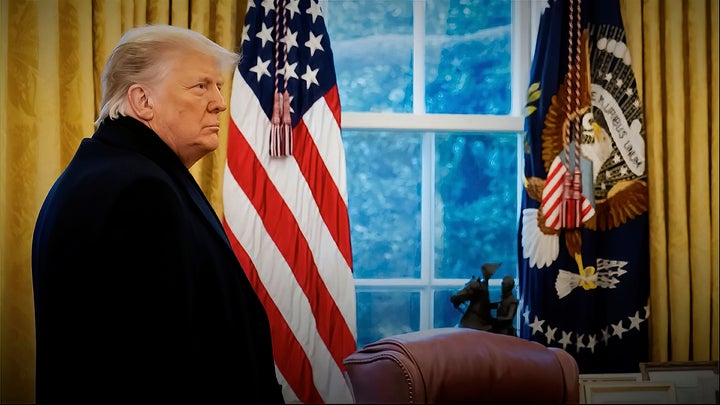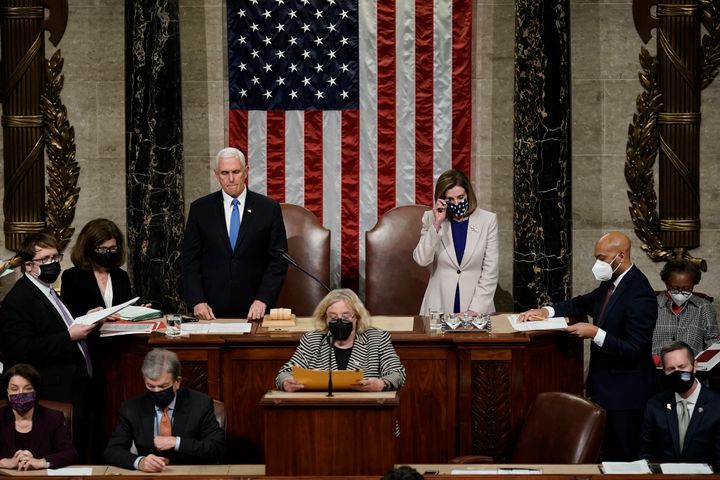Former President Donald Trump has been indicted over his attempt to remain in power after he lost the 2020 presidential election, yet another moment of reckoning amid a torrent of criminal charges.
Trump faces four felony charges as part of a sweeping, 45-page indictment filed in the U.S. District Court for the District of Columbia. Special counsel Jack Smith’s team of investigators accused the former president of multiple conspiracies to defraud the United States, to obstruct an official proceeding and to deprive people of their right to vote and have that vote counted under the Constitution.
Here are seven key things to know.
1. Trump knew his claims were false but spread them anyway to create an “intense national atmosphere of mistrust and anger.”
Prosecutors note that Trump, like every American, had the right to speak publicly about the election “and even to claim, falsely,” that there had been “outcome-determinative fraud.”
But his efforts became unlawful when he moved to defraud the United States and attempt to subvert the process of collecting, counting and certifying the election results. That plan, the indictment says, included a multi-prong approach to spread lies, install slates of fake electors in swing states and convince election officials and then-Vice President Mike Pence to subvert the will of the people.
“Despite having lost, the Defendant was determined to remain in power,” the indictment says.

2. The indictment identifies six co-conspirators.
Trump was aided in his effort to overturn the 2020 election by six unnamed co-conspirators, the indictment says.
Five of them are identifiable through details and information provided in the filing documents:
1. Rudy Giuliani is listed as “an attorney who was willing to spread knowingly false claims and pursue strategies that the Defendant’s 2020 re-election campaign attorneys would not.”
2. John Eastman is listed as “an attorney who devised and attempted to implement a strategy to leverage the Vice President’s ceremonial role overseeing the certification proceeding to obstruct the certification of the presidential election.”
3. Sidney Powell is listed as “an attorney whose unfounded claims of election fraud the Defendant privately acknowledged to others sounded ‘crazy.’”
4. Jeffrey Clark is identified as “a Justice Department official who worked on civil matters and who, with the Defendant, attempted to use the Justice Department to open sham election crime investigations and influence state legislatures with knowingly false claims of election fraud.”
5. Kenneth Chesebro is listed as “an attorney who assisted in devising and attempting to implement a plan to submit fraudulent slates of presidential electors to obstruct the certification proceeding.”
6. The sixth co-conspirator is so far unknown but is identified as “a political consultant who helped implement a plan to submit fraudulent slates of presidential electors to obstruct the certification proceeding.”
3. People in Trump’s orbit repeatedly told him there was no evidence of voter fraud.
The indictment alleges Trump and his co-conspirators made repeated, “prolific” claims of election fraud despite knowing they were false. Prosecutors say that Trump was repeatedly told by his inner circle his claims were untrue but that he “deliberately disregarded the truth.”
Smith’s team pointed to conversations Trump had with Vice President Mike Pence, senior leaders at the Justice Department, the director of national intelligence, the Department of Homeland Security and many aides, White House attorneys and campaign staffers, all of whom said his claims were unsubstantiated.

4. Trump acknowledged claims about election fraud and voting machines pushed by a co-conspirator sounded “crazy.”
The indictment notes that even as Trump’s legal advisers were working to undercut election results in Georgia, he knew the claims were unfounded and even described Co-Conspirator 3’s plan as “crazy.”
That sentiment spread through Trump’s close advisers as the effort to install slates of fake electors in swing states began in force in an effort to obstruct a true count of the Electoral College votes.
“Here’s the thing the way this has morphed it’s a crazy play so I don’t know who wants to put their name on it,” Trump’s deputy campaign manager at the time texted to other aides. No one agreed to put their name on the plan as they couldn’t “stand by it.”
5. Trump pressured the Justice Department to support him and threatened to remove those who refused to go along with his plan.
Trump repeatedly tried to get the Department of Justice to support his false claims of election fraud, “thus giving the Defendant’s lies the backing of the federal government.” But the acting attorney general and acting deputy attorney general both refused, saying the agency would not and could not change the outcome of the election.
“Just say that the election was corrupt and leave the rest to me and the Republican congressmen,” Trump replied, the indictment says.
The former president then attempted to install Co-Conspirator 4 as acting attorney general to help further the plot. Trump backed down after many in the White House threatened a mass resignation.

6. Pence’s notes helped the special counsel craft his case.
Trump heavily pressured Pence to support his effort to remain in power and reject the ceremonial certification of Joe Biden as the winner of the election.
Prosecutors pieced together details of Trump’s conversations and thinking around the time using Pence’s “contemporaneous notes” in the days leading up to Jan. 6.
The vice president rejected Trump’s attempts, telling him to his face that he didn’t believe he had the authority to do what Trump asked.
Trump later told Pence that he would have to publicly criticize him, the indictment says, which prompted his chief of staff to inform the Secret Service about fears for Pence’s safety.
7. Trump waited and watched on TV as his supporters stormed the Capitol.
The indictment claims Trump exploited the violence at the Capitol on Jan. 6 and resisted pleas from his aides and supporters to speak out as the insurrection grew.
“When advisors urged the Defendant to issue a calming message aimed at the rioters, the Defendant refused, instead repeatedly remarking that the people at the Capitol were angry because the election had been stolen,” the document says.

